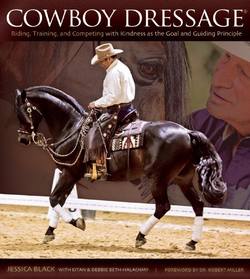Читать книгу Cowboy Dressage - Jessica Black - Страница 19
На сайте Литреса книга снята с продажи.
Cowboy Dressage or Western Dressage?
ОглавлениеIn 2010, the Western Dressage Association of America was created to organize some aspects of the budding new discipline inspired by Eitan Beth-Halachmy and his work with horses such as Holiday Compadre and Santa Fe Renegade. At the time, people were using the terms “Cowboy Dressage” and “Western Dressage” interchangeably. Some people still do, and this can lead to confusion, although in many ways, Cowboy Dressage and Western Dressage are similar.
Both trace their roots back to the inspiration of Eitan Beth-Halachmy, and the sacrifices he and Debbie made in order to share the vision with a wider audience. Cowboy Dressage and Western Dressage can appear very similar, perhaps due to the shared origin—Eitan on Holiday Compadre will forever be the founding image for both, the spark that lit the fire. However, they are gradually evolving to fit the needs of different groups of people, and as time goes by, the differences become more apparent.
Some groups try to minimize the difference: in Oregon, the Cowboy/Western Dressage Alliance caters to those who want to do one or the other, or both. In fact, many people who are active in the Cowboy Dressage community also compete in Western Dressage. Cowboy Dressage clubs keep up with the events in Western Dressage circles, and vice versa. Riders who want to do both have many opportunities to do so, and are often successful in both arenas (fig. 1.5).
1.5 – Melissa Walker and GPM Genesis B compete successfully in both Western Dressage and Cowboy Dressage. Here they are shown with Western Dressage ribbons won at the 2013 World Championship Morgan Horse Show.
It can still be difficult for anyone but the connoisseur to say what differentiates the two. Both emphasize the relationship between horse and rider. Both seek to combine the best of the Western cowboy tradition and traditional dressage; both focus on training that takes into consideration the horse’s nature.
The differences? Cowboy Dressage puts more emphasis on lifestyle and the diversity of its community. Western Dressage is easier for those already on the USEF (United States Equestrian Federation) show circuit. Western Dressage relies a little more on the traditional dressage aspect; Cowboy Dressage, in accordance with its name, leans more toward the cowboy, or Western-style horse. Cowboy Dressage emphasizes its unique style that caters to the specific way of going of a Western horse, whereas Western Dressage focuses on a horse that can multitask, accommodating the bigger gaits and specific movements of traditional dressage to Western tack.
As the two disciplines have forged their own paths, growing apart in some ways along the line, the differences are becoming apparent mainly in competition rules and venues—you will find Western Dressage divisions at major USEF horse shows; Cowboy Dressage organizes its own events. Accordingly, Western Dressage has its section in the USEF rulebook, which largely applies the rules of traditional dressage to horses shown in Western tack.
In contrast, Cowboy Dressage is in the process of creating and expanding its own rules, adding to them as more and more people ask for more divisions and more tests. Over the past few years, the increasing demands of an expanding community have led to the development of guidelines for shows and judges, using classical dressage techniques and testing methods to build a better Western horse.
The biggest differences between Cowboy Dressage and Western Dressage are seen in the tests. Western Dressage has opted for an arena and tests that are very similar to traditional dressage competition. Cowboy Dressage took the traditional dressage arena and turned it into a classroom for the Western horse, resulting in a unique court with patterns scaled to the movements and goals of Western horses.
For the most part, what one notices about Cowboy and Western Dressage is that, although their rules and competitions are becoming increasingly different as both carve out their own special niche in the horse world, people from either tend to support the other. Importantly, both grew out of the vision of Eitan and Debbie Beth-Halachmy, with the enthusiastic collaboration of many, in order to offer new possibilities for training and showing, always emphasizing, above all, the relationship between horse and rider.
1.6 – Both Cowboy Dressage and Western Dressage owe their existence to the magical partnership of a man and a horse. In this photo, Eitan Beth-Halachmy and Holiday Compadre compete in Western Pleasure at the 1992 World Championship Morgan Horse Show. Although no one knew at the time, the efforts of Eitan and Compadre would sow the seeds of a new discipline.
